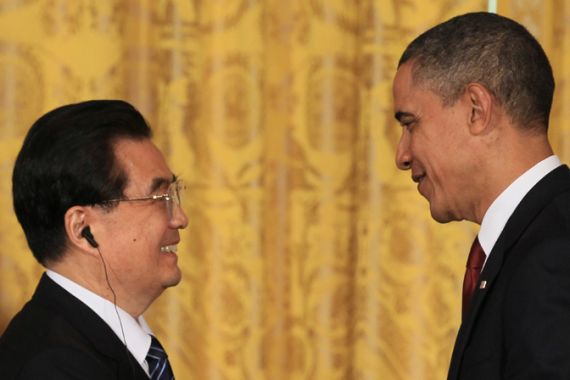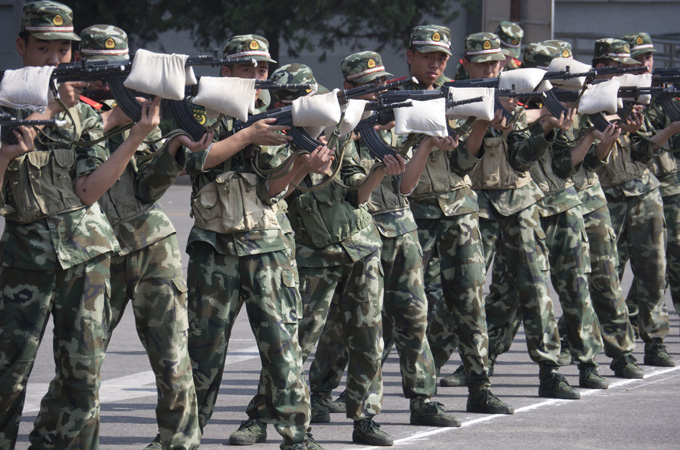Obama and Asia’s two futures
Asia, and China in particular, must embrace multilateral peace or risk being constrained by its military alliances.

 |
| China’s growing spending on its internal security surpassed its international defence spending in 2011 [EPA] |
Despite the relentless shift of global economic might to Asia, and China’s rise as a great power – the central historical events of our time and which will drive world affairs for the foreseeable future – the focus of the United States has been elsewhere. The terrorist attacks of 2001, followed by the Afghanistan and Iraq wars, the Great Contraction of 2008, the Arab Spring, and Europe’s sovereign debt crisis, all diverted the US from helping to create a lasting structure of peace to accommodate today’s resurgent Asia.
In November, US President Barack Obama can begin to redress this imbalance when he hosts the Asia Pacific Economic Cooperation summit in his native state of Hawaii. The meeting’s timing is fortunate, because a number of critical Asian issues are coming to a boil.
The South China Sea, for example, is now churning with competing claims to its islands, atolls, and sea bed, including China’s bold assertion that all of it is sovereign Chinese territory. At this year’s ASEAN summit in Bali, it was agreed that these territorial disputes be settled through bilateral negotiations. But the scope of Chinese claims doomed that agreement from the start; indeed, China now insists that the sea constitutes a core national interest, on a level with Taiwan and Tibet, for which it is prepared to fight.
China’s willingness to throw its weight around amplifies the grave imbalance in size, and leverage, between it and the other countries bordering the South China Sea. This has made bilateral negotiations to settle these disputes unviable. Vietnam and the Philippines have been bullied in this way recently, with both pushing back rather than submit to Chinese-imposed terms.
The presidential elections scheduled for next year in two of Asia’s strongest democracies – South Korea and Taiwan – are also likely to cause diplomatic temperatures to rise in the months ahead. The risk stems not from the conduct of the South Koreans or the Taiwanese, but from the democratic choices that they make, which may offend two of Asia’s last dictatorships.
In South Korea, the remarkable Park Guen-hye’s bid to become her country’s first woman president may provide an excuse – as if any were needed – for North Korean mischief-making. The regime in Pyongyang is seeking to ensure that power passes to a third generation of Kims, represented by the pudgy and well-fed “Dear Young General”, Kim Jong-un, and appears to believe that provocations such as its bombardment of a South Korean island earlier this year are the way to secure the succession.
Taiwan, too, may elect a woman president, Tsai Ing-wen, the leader of the opposition Democratic People’s Party, next year. That outcome would stoke Chinese ire, not because of Tsai’s gender, but because of her politics. The DPP has long been the Taiwanese party keenest on securing independence for the country.
A third Asian issue with combustible potential is in Myanmar, where another unique woman, the Nobel Peace Prize winner Aung San Suu Kyi, is at the heart of events. The elections earlier this year, which many at first assumed were a sham, now appear to have produced changes to which Asia’s countries will need to collectively and individually respond. The government not only freed Suu Kyi after two decades of house arrest, but has even begun a dialogue with her – talks for which the meticulous opposition leader has expressed real hope.
Indeed, President Thein Sein’s government has begun to release thousands of political prisoners, including the monk who led the massive street protests of 2007. Sein’s government has also listened to public disquiet at China’s massive influence in the country, and has cancelled a huge $3.6bn dam that Chinese firms were building.
China, it is plain to see, is at the root of most of the disputes troubling Asia. Two main issues must be managed – one philosophical, the other structural – in seeking to ameliorate the problems caused by China’s unconstrained rise. Only by resolving the structural issue will Asia succeed in overcoming the philosophical problem.
The philosophical problem concerns China’s renewed conception of itself as the “Middle Kingdom”, a state with no sovereign equal. Throughout its history, China has sought to treat its neighbours as vassals – a mindset currently reflected in the way that it has approached negotiations with Vietnam and the Philippines over the South China Sea.
China’s free-floating rise, unanchored in any regional structure or settlement, makes this mindset particularly worrying. At the Hawaii summit, Obama must orchestrate the first steps toward constructing an effective multilateral framework within which the complications posed by China’s rise can be addressed.
The absence of such a structure of peace has been obscured, to some extent, by the dominant role of the US in Asia since the Pacific War. But China’s rise and the other global and domestic concerns of the US have left many Asians wondering just how enduring those commitments will be in the future. Nevertheless, China’s recent strategic assertiveness has led many Asian democracies to seek to deepen their ties with the US, as South Korea has done with a bilateral free-trade agreement. The US is reciprocating by pledging not to cut Asia-related defence spending, despite the large reduction in overall US defence spending that lies ahead.
What Asia needs most today is a well-conceived regional system, embedded in binding multilateral institutions. A “Trans-Pacific Partnership” between Australia, Brunei, Chile, Malaysia, New Zealand, Peru, Singapore, the US, and Vietnam to govern supply-chain management, intellectual-property protection, investment, rules on state-owned firms, and other trade issues – likely to be announced in Hawaii – is a good start in the economic sphere. But much more is needed.
Ultimately, the best way for peace to prevail in the region is for the US and China to share responsibility for a regional order with Asia’s other powers, particularly India, Indonesia, Japan, and South Korea.
Asia’s choice is clear: Either the region embraces a multilateral structure of peace, or it will find itself constrained by a system of strategic military alliances. In Hawaii, Obama and the other assembled Asian leaders – particularly the Chinese – must begin to choose between these two Asian futures.
Yuriko Koike is Japan’s former Minister of Defence and National Security Adviser.
A version of this article previously appeared on Project Syndicate.
The views expressed in this article are the author’s own and do not necessarily reflect Al Jazeera’s editorial policy.
